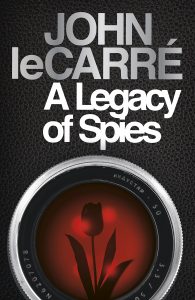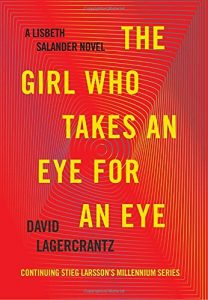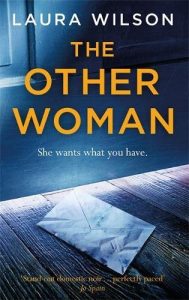 A Legacy of Spies by John le Carré
A Legacy of Spies by John le Carré
The Girl Who Takes an Eye for an Eye by David Lagercrantz
The Seagull by Ann Cleeves
The Other Woman by Laura Wilson
September brings a batch of old favourites. If, like me, you grew up with John le Carré’s Smiley novels, you will fall on A Legacy of Spies with shrieks of delight. Peter Guillam, the ever-faithful junior to George Smiley, is now old and retired to a family farm in Brittany. He’s summoned back to London, to the spies’ ‘ostentatious’ palace on the Thames, to answer for his service’s Cold War activities. The people now in charge are trying to feed  the public’s passion for historical crimes by looking into the operation le Carré first described in The Spy Who Came in from the Cold, in which Alec Leamas and Liz Gold were killed to protect an East German source. He left a son and she a daughter when they died and those, now adult, are trying to sue to the service.
the public’s passion for historical crimes by looking into the operation le Carré first described in The Spy Who Came in from the Cold, in which Alec Leamas and Liz Gold were killed to protect an East German source. He left a son and she a daughter when they died and those, now adult, are trying to sue to the service.
At first Guillam treats his inquisitors to the most parsimonious possible delivery of insignificant facts, but he’s soon forced into admitting more. He has to reveal the existence of documentary evidence left in the safe house from which the operation was run. This house is still funded, even though the current officers knew nothing of its existence, and run by the live-in housekeeper Millie McGraig. How Millie managed to administer both this house with all its secrets and the one Bill Haydon set up to facilitate Operation Witchcraft, his illicit dealings with the Russians described in Tinker, Tailor, Soldier, Spy, is a puzzle. Perhaps le Carré included Millie, as well as some contradictory accounts of Guillam’s parentage, with the mischievous intention of warning alert readers that they should never trust an old spy – or a novelist.
For longstanding devotees of Smiley and Bill, Peter and Toby, poor Jim Prideaux, Mendel, Control, and all the rest of the denizens of the Circus, there are many pleasures in A Legacy of Spies. We learn more about how the vile Stasi operative came to work for the British, but nothing else is added to our  understanding of the history and management of the Circus, and the new story comes alive only at intervals. I am glad to have read it – and to have shared in le Carré’s anger about Brexit and other modern horrors – but this is only a shadow of his great novels.
understanding of the history and management of the Circus, and the new story comes alive only at intervals. I am glad to have read it – and to have shared in le Carré’s anger about Brexit and other modern horrors – but this is only a shadow of his great novels.
David Lagercrantz took on the tricky job of following Stieg Larsson’s bestselling trilogy with sequels developing his predecessor’s characters. Lagercrantz is a much better writer than Larsson, and The Girl Who Takes an Eye for an Eye is well structured and well paced. Lisbeth Salander is still angry, tormented, and preternaturally able to survive physical injuries that would kill anyone else. As this novel opens, she is in prison and contemptuous of the staff’s submission to a sadistic inmate. One of the inmate’s victims is a gentle, beautiful victim of  honour violence, who eventually hit back and killed her persecutor. Salander, hating cruelty and bullying as she always has, must intervene.
honour violence, who eventually hit back and killed her persecutor. Salander, hating cruelty and bullying as she always has, must intervene.
Her activities offer great fun, which feels more than a little uncomfortable in the context of the most appalling abuse of children. This novel develops the story of what was done to the young Salander and reveals official and institutional cruelty of the most hideous kind. Some of the perpetrators are still alive and determined to erase all evidence of their old activities, while she is determined to reveal everything through Mikhael Blomkvist’s magazine. The resulting battle requires a large suspension of disbelief, but realism was never one of the charms of the original series either.
 Ann Cleeves’s DI Vera Stanhope takes on another case in The Seagull, offering readers all the familiar pleasures of her sharp perception and chaotic private life. This time the investigation is sparked by information given to her by John Brace, a bent cop, now serving a long sentence. Here, too, a novelist is tackling the British public’s passion for digging up old crimes and punishing them with far more severity than they would have aroused at the time the offence was committed.
Ann Cleeves’s DI Vera Stanhope takes on another case in The Seagull, offering readers all the familiar pleasures of her sharp perception and chaotic private life. This time the investigation is sparked by information given to her by John Brace, a bent cop, now serving a long sentence. Here, too, a novelist is tackling the British public’s passion for digging up old crimes and punishing them with far more severity than they would have aroused at the time the offence was committed.
Brace was a friend of Vera’s father and the new case brings back all  kinds of painful memories of her tricky childhood. Nothing she suffered was a patch on Lisbeth Salander’s torment, but it is considerably more credible. The old officer’s revelations lead to the discovery of two bodies and a very murky story about the heroin-addicted prostitute who bore Brace’s child and then disappeared. The child is now a divorced mother of three, depressed and struggling. Vera’s dealings with her reveal a much softer, and kinder, woman than the abrasive and demanding one her team know so well.
kinds of painful memories of her tricky childhood. Nothing she suffered was a patch on Lisbeth Salander’s torment, but it is considerably more credible. The old officer’s revelations lead to the discovery of two bodies and a very murky story about the heroin-addicted prostitute who bore Brace’s child and then disappeared. The child is now a divorced mother of three, depressed and struggling. Vera’s dealings with her reveal a much softer, and kinder, woman than the abrasive and demanding one her team know so well.
Ann Cleeves offers no scenes of graphic violence, let alone torture, and the pleasures of her work are those of watching fundamentally good people diligently wearing down the fundamentally bad and getting some kind of justice for their victims.
 Laura Wilson, who has been writing serious, elegant and well researched novels about damaged and dangerous people for some time, offers something different in The Other Woman. To outside eyes Sophie has everything: a rich husband who works in the City during the week and returns home to Norfolk at the weekend; three children; a beautiful house; and a charming little business run with her best friend, Melissa. Of course nothing is ever quite as perfect as it looks, and Sophie has to deal with her perfectionist daughter’s incipient anorexia and teenage Zach’s inability to keep track of his possessions or clear up after himself. She also has a difficult mother and uncomfortable childhood memories. But her life is good enough to make her worry about sounding smug in her annual Christmas-card newsletter. She’s a stubborn woman, too, and won’t be put off sending these round-robins, even though someone on her Christmas-card list sends them back each year annotated with insults. When the latest one arrives with an announcement that Sophie’s husband is having an affair and about to leave her, she has to take action.
Laura Wilson, who has been writing serious, elegant and well researched novels about damaged and dangerous people for some time, offers something different in The Other Woman. To outside eyes Sophie has everything: a rich husband who works in the City during the week and returns home to Norfolk at the weekend; three children; a beautiful house; and a charming little business run with her best friend, Melissa. Of course nothing is ever quite as perfect as it looks, and Sophie has to deal with her perfectionist daughter’s incipient anorexia and teenage Zach’s inability to keep track of his possessions or clear up after himself. She also has a difficult mother and uncomfortable childhood memories. But her life is good enough to make her worry about sounding smug in her annual Christmas-card newsletter. She’s a stubborn woman, too, and won’t be put off sending these round-robins, even though someone on her Christmas-card list sends them back each year annotated with insults. When the latest one arrives with an announcement that Sophie’s husband is having an affair and about to leave her, she has to take action.
Wilson’s account of Sophie’s revenge is full of the darkest humour, and it is both clever and persuasive. Unlike many of the other domestic-noir novelists, she avoids the temptation of providing a neat ending and so adds real feeling to the excitement and farce of Sophie’s adventures. The Other Woman shows a new aspect of Wilson’s imagination, and it should be greeted with cheers and trumpets.
